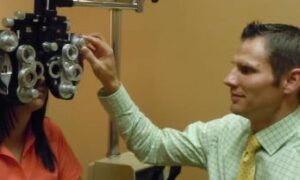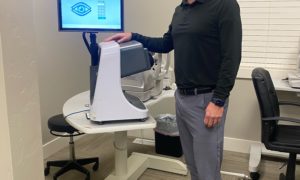
May 11, 2016
Your patients may be using their digital devices even more than you suspected, The Vision Council’s new report, Eyes Overexposed: The Digital Dilemma, suggests. According to the report, nearly 60 percent of Americans use digital devices for five or more hours each day and 70 percent of Americans use two or more devices at a time. Some 77 percent of the individuals who suffer from digital eye strain use two or more devices simultaneously. Seventy percent of women report experiencing symptoms of digital eye strain and are more likely than men to simultaneously use multiple devices.
I have a smartphone, a tablet and a laptop. At any given time, I am often using two of the devices simultaneously. Occasionally, I am using all three simultaneously. To make matters more interesting, I often work with the television on in the background. That’s four screens. To further complicate this mix, I can be working in the same room with my spouse who is also working on a laptop and using a smartphone. Both of us will often ask the other to read something on one of our screens. That takes us to five or more screens.
Clearly, we are no longer at just one working distance. Today’s work environment distances are flexible and constantly changing.
We are not alone. More and more people have multiple working distances for more and more of their day. Keep in mind it is not enough to ask our patients about the distance from their eyes to one screen. We must now know all their working distances for all of their digital devices.
And working height is equally important to working distance. A tablet is often not hand-held; they come with keyboards that put them back on the desktop. Or the tablet may be passed from one person to the next at varying heights. So, just knowing it is a tablet is not enough. At what height is the tablet screen when you use it … and does it vary? And where do you hold your phone when reading or responding to e-mail?
All of this leads us to Digital Eye Fatigue Syndrome. It is very important to educate our patients about Digital Eye Fatigue Syndrome. This used to be known as Computer Vision Syndrome, but with today’s explosion of smartphones and tablets, Digital Eye Fatigue Syndrome is a better descriptor.
People struggling with this problem can start with simple approaches such as:
-
• Take regular breaks from computer work.
• The 20-20-20 rule: every 20 minutes, look away 20 feet (or more) for 20 seconds.
• Post a note that says “Blink” on screens to remind yourself to blink.
• Move screens a little below eye level.
• Use a glare filter over your screen.
If those simple approaches do not relieve the discomfort, then the next level should be an eye exam to make sure the patient has the most current prescription in their glasses or contact lenses.
The next level up is the prescription of occupational lenses.
All of this is predicated on the premise that your patients even think about an eye exam when suffering from the symptoms of Digital Eye Fatigue Syndrome. Patient education and targeted marketing are key to make sure this happens.
Your action plan for this week has two parts:
First, walk around your practice and page through your web site and social media to see how effectively you are educating people about the symptoms and solutions for Digital Eye Fatigue Syndrome. To help you with this step, answer these three questions:
1) Have you highlighted the pain associated with Digital Eye Fatigue Syndrome and the action step that people need to come see you, even if they have had a recent eye exam, and definitely come see you if it has been more than a year since their last eye exam?
2) Have you educated people that Digital Eye Fatigue Syndrome occurs even when people can see clearly?
3) Have you marketed in your practice that Digital Eye Fatigue Syndrome is something that you can diagnose and treat in your practice? Some practices have highlighted that they are a Dry Eye Center of Excellence in order to market to patients that their practice is the place to come if they are experiencing the problem of Dry Eye Syndrome. Why not highlight in your practice that you are the Digital Eye Fatigue Syndrome Center of Excellence to market to patients in your practice that your practice is the place to come if a person is experiencing the problem of Digital Eye Fatigue Syndrome?
Second, create a treatment protocol for Digital Eye Fatigue Syndrome. Your treatment protocol should have at least the following solutions:
• Changes to the work environment such as glare management, working distance and working height.
• Changes to personal working style such as blinking, visual breaks and stress management.
• Changes to lenses such as current prescription and occupational lenses.
Helping people be more productive at work, and to live a higher quality of life all day long, is what we do. To do it completely, we need to make sure that we are effectively managing Digital Eye Fatigue Syndrome.



























